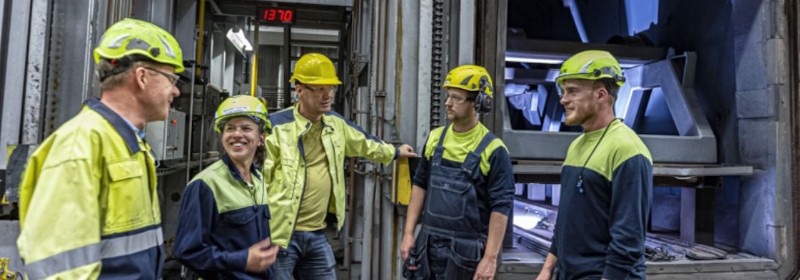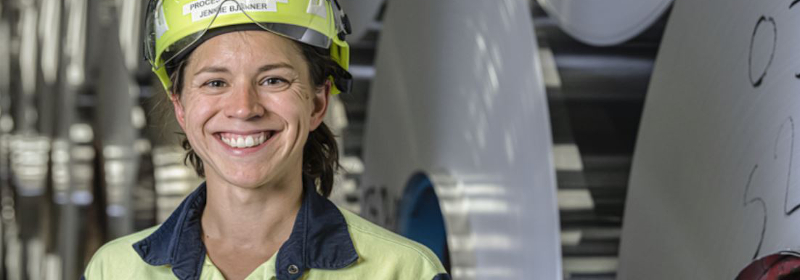Finding the right flow
Thanks to the close cooperation of teams in Finspång and Shanghai, there is now a method in place for optimizing the airflow to the annealing furnaces.

Awaiting new furnaces. The new method will be introduced in Finspång after the replacement of two older furnaces with six new ones. With the colleagues. Anders Johansson, Jennie Bjerner, Niclas Gustafsson, Niklas Peterson and Björn Strand.
Jennie Bjerner works as process engineer at the Finspång facility and is one of the members of the cross functional team assigned to developing suggestions for how Gränges could achieve a more optimized airflow to the annealing furnaces.
The team started working on the task in 2014. Primarily, the goal was to investigate what needed to be done to achieve a more evenly distributed temperature in the coils, and to decrease the material temperature variations, in order to match tighter specification needs from customers.
In recent years, several customers have requested material qualities with coil temperature tolerances of just +/- 5 degrees Celsius. Additionally, the team investigated the furnaces’ capability of ensuring that Gränges fulfills CQI-9, the vehicle industry’s standard for heat treatment system assessment.
“Since 2015 we have together with research institute Sintef performed computer simulations on the annealing furnaces,” says Bjerner.
“In short, the tests have focused on how the coil temperature is affected by different airflow volumes and different air temperatures. We have also conducted additional experiments to validate the simulation model.”
Thanks to these experiments, the team managed to pinpoint the airflow needed to even out the temperature. The new method is already up and running in Shanghai, after the replacement of two older furnaces with new ones. In 2020, there is a plan to implement the method n Finspång, when the facility constructs a new rolling mill with six new annealing furnaces with four coils each. Bjerner says it has been highly stimulating to work across functions with colleagues from Research & Innovation, Process Development, Maintenance and Production Technique. On average, the team has met once a week to discuss improvements.

“Stimulating work”. Jennie Bjerner, a process engineer in Finspång appreciated to work in a cross-functional, cross-border team.
And the work continues; the next step will be to examine the annealing programs. Thanks to better heat transfer in the coils there is a potential to reduce the program time, with retained materials quality.
“We constantly test new ideas, and everybody contributes to the process with new perspectives. It really feels like we are on an upward trajectory,” says Bjerner.
Hua Chen has been the team’s project manager in Shanghai. He says the cooperation between the facilities in Finspång and Shanghai, the research institute Sintef and the supplier SDF has been very successful.
“We have concrete proof that our new annealing furnaces have a faster process time and less temperature variations,” he says.
Recognition for innovative ideas
For their work with optimizing the airflow to the annealing furnaces, a cross-functional team from Shanghai, Finspång and Headquarters won the Innovation category in Gränges Company Awards.
The jury’s motivation
“The project was formed based on tighter specification needs from our customers. The solution was developed by using scientific methods combined with hands-on process competence. The result was a process that outperformed what was previously used by Gränges, and what is offered to the market by specialized equipment manufacturers.”

 svenska
svenska
 中文(中华人民共和国)
中文(中华人民共和国)




